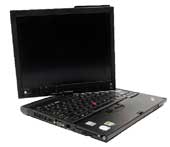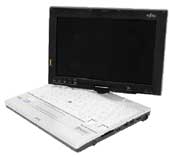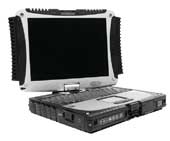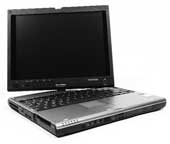Tablet PCs certainly have had a bumpy ride since their inception. A little bit like the flying car or the personal jet pack, they have inspired people to dream about the possibilities but never achieved mainstream acceptance over the more common laptop PC or desktop tower.The heyday of interest in tablets probably occurred in 2002, when Microsoft introduced the Windows XP Tablet operating system. At the December 2001 Comdex Computer Show, back when there was a Comdex, a huge Microsoft launch party was attended by 10 companies, each showing their version of a tablet computer. Even monitor manufacturers such as ViewSonic threw their hat into the ring with tablet PC offerings. In a keynote speech, Bill Gates predicted that within five years, the sales of tablet computers would outstrip laptops. The era of the tablet had begun, or so it seemed.Obviously, that grandiose vision never happened. Most companies that offered pure slate tablets ' the truest tablet PC format ' have either shifted their focus or left the market. Despite the advantages of handwriting recognition and an intuitive pen-based interface, users just could not give up the security blanket of a keyboard to access their work. The only real surviving form factor in the tablet market today is the convertible laptop. The convertible can be used like a regular laptop but can flip its screen 180 degrees, plop down and lock over the keyboard, making it a somewhat bulky tablet ' or at least more bulky than the dying slate models.But despite the extra weight and girth of convertible tablets, the ability to quickly transform back into a laptop kept this model alive. Although we ran all our performance testing with the five tablets in our review in tablet format, we found ourselves setting up all the tests with the units in standard laptop configuration. It's just much easier to work with the keyboard.However, faster chips that run cooler, and some new designs, make these five convertibles not quite as chunky as you might expect. The heaviest tablet in the review was just 5 pounds, and that was a fully rugged model suitable for workers in the field or even the military. The lightest was only 2 pounds.So, it seems that with convertible tablets, you might finally be able to have your cake and eat it too. You can have the performance and features of a laptop PC and nearly the sleek package and portability of a slate tablet. Just configure your device as needed for the given situation. A A A A- A Lots of innovative features, great battery life, excellent value. Optical drive requires docking station.[IMGCAP(1)]The Lenovo ThinkPad X60 Tablet PC is a bit of a throwback to the glory days of tablet PCs, when innovation and cool features ruled the roost. The X60 includes a number of interesting features that got us excited about tablet PCs once again. Even so, it managed to win top marks in our performance testing. It seems Lenovo took a lot of risks with the X60, and they all seem to have paid off.The X60 got the highest PassMark rating in the review, scoring 459 overall. It is very fast when processing 2-D graphics with its 1.83 GHz Intel Core Duo L2500 processor or rushing calculations through its 1G of memory. It was a touch slower when dealing with 3-D graphics, but still no slouch.For storage, it was better than most systems in the review, with a 100G, 7,200 RPM hard drive.The X60 has a lot of nice extras not found on other tablets. The coolest is that the screen can automatically sense its orientation and rotate for proper viewing.And it will rotate in all four directions around the screen. Whether you have the 12.1-inch XGA screen positioned so the rectangle is tall or wide relative to you, the screen will be correctly displayed right side up. So, you could be taking notes or working on a presentation and just flip the screen over so someone else can view it. We changed the screen orientation many times, even while playing a movie, and it never missed a beat.There is also a little ring on the side of the screen that you could use like an analog control pad for simple cursor movements, such as paging through a document or moving the selected icon across the Windows screen. This handy gadget adds functionality for some tasks, and you can simply ignore it for others.The unit weighs 4 pounds, 10 ounces, which is a little heavy. But this includes an eight-cell battery that helped the X60 last for 3 hours, 25 minutes in our worst-case scenario testing. In normal conditions, the X60 would easily have enough power to get you through almost any cross-country flight.There are three USB ports placed around the unit so you can access some of them whether the X60 is in tablet or laptop format. It also has a security chipset, standard in Lenovo laptops, plus a fingerprint reader.Given the performance and features found in this high-quality convertible, the government price of $1,875 is excellent and surprising. Most tablets in this roundup cost more and offer less. As such, the X60 earns the GCN Lab Reviewer's Choice designation and our gratitude for rekindling our interest in tablet PCs. If you are looking for a cutting-edge tablet that also functions great as a laptop, you can't go wrong with an X60.Lenovo, Research Triangle Park, N.C., (866) 458-4465, www.lenovo.com/us B- B A B- A- Small and light, top scorer for font manipulation and office graphics. Bad 3-D performance, tiny keyboard may be too small for some users.Fujitsu may not be the first name that comes to mind for laptop PCs, but given the company's performance in the last few GCN Lab reviews, perhaps it should be.Fujitsu is taking the lead in innovation in a lot of areas. The Lifebook P1610 follows this trend. Of all the tablets in this review, the P1610 stands out from the usual form factor. Whether or not this makes the P1610 the perfect tablet or a bad fit for you depends on your job responsibilities and preferences.The P1610 is the smallest and lightest tablet in the review, at 2 pounds, 3 ounces. When converted into tablet form, the device is only slightly bigger than its 8.9-inch touch display screen. You can almost slip it into the outside pocket of a suit, something the others in this review would never be able to achieve.One problem with the size, at least for some people, is that the keyboard is tiny, so those with large fingers might have trouble working with it for long periods of time. In addition, the screen size limits its effectiveness as a tablet, although the trade-off of a small size and light weight could trump this fault for many people.The Intel Core Solo U1400 Ultra Low Voltage processor performed surprisingly well on the PassMark benchmarks, scoring 234 in overall performance. Although this was the lowest score in the review, if you analyze these results you will find areas in which the P1610 really shines. The P1610 performed near the top of the heap in detailed tests with 2-D graphics. That means that standard office applications like Word and Excel will fly. It scored the top mark when working with text and fonts, another nod to office application work. It has 1G of DDR2 RAM, too, which performed quite well in our testing.Only intense 3-D modeling caused the P1610 to stumble, something most standard office users won't care much about. The 4,200 RPM 80G Parallel Advanced Technology Attachment hard drive also was a little slow on heavy reading and writing tasks, which might prove a problem for users that install large programs or transfer a lot of data.The battery power for the P1610 lasted 1 hour, 58 minutes during our torture tests. Because we test systems while running video clips, it causes the hard drive to spin and also forces the speakers to remain powered, so this is a worst-case scenario. We expected this tiny tablet to last a bit longer. However, when you consider that it is running off a three-cell battery, the two-hour time limit is not bad.Fujitsu found a way to squeeze two USB ports onto the tiny tablet. There is also a Gigabit Ethernet port and a standard V.90 modem. And it comes with IEEE 802.11a/b/g wireless, so you can connect to any network currently in existence, until the 802.11n standard hits the scene.As configured for our testing, the little P1610 has a government price of $2,044, making it a good deal if size and weight are your primary concerns. On the road, those who need to compose standard office documents and access the Web will find it a great tool without adding too much to their travel burdens.Fujitsu Computer Systems, Sunnyvale, Calif., (800) 831-3183, www.computers.us.fujitsu.com B+ B B A- A- Good screen, good value, built-in optical drive. A little on the heavy side for a tablet.The Gateway E-155C is an excellent value for a convertible tablet that runs the gamut between a full business class laptop and a tablet PC. It did not blow away the competition in any one particular area, but neither did it have any of the tragic flaws of some of the other units we tested.The E-155C could seem a little heavy for a tablet, at 4 pounds, 12 ounces, but considering it has a built-in multiformat double-layer DVD writer and a 6-in-1 digital media reader, you might not mind the extra pound or two.The E-155C we tested featured an Intel Core 2 Duo Ultra Low Voltage U7500 Processor and 1G of DDR 2 memory. Its PassMark score of 333 was right in the middle of the pack. It excelled in the area of 3-D graphics handling, where it scored second, proving that the E-155C is not designed to be solely a tablet or a laptop but straddle the two worlds.It has a lot of features, including a fingerprint reader that is in a good position to be used whether in laptop configuration or as a tablet. There are two USB ports in addition to the media reader.It has a Gigabit Ethernet port for those of you lucky enough to have access to such a network, but it will scale downward for those who don't. There is also an integrated Intel 802.11a/b/g wireless chip. And if you get stuck in a hotel without any of the above options, there is also a V.92 modem.The screen is a generous 12.1-inch WXGA thin-film transistor that is one of the best looking in the review. It looks a lot better indoors, and in standard office lighting situations, it really shines.Given the large screen and the optical drive, we expected the E-155C to die quickly in our battery life testing. The E-155C however, had other ideas. It lasted 2 hours, 1 minute in our worst-case scenario. Given the four-cell battery, that is impressive. Like the other components, it did well with everything without really owning any one area.The computer's list price of $2,073 was good because you get a lot of features and no real substantial flaws. Government buyers can expect some type of discount off that price.The E-155C might not be the ideal tablet, but it might be an ideal buy for agencies that want to dip their toes into the tablet market without moving too far from the safe shores of laptop computing.Gateway, Irvine, Calif., (800) 216-2940, www.gateway.com B+ A C+ B+ B Excellent battery life. Hard-to-use form factor.Panasonic's Toughbook CF-19 has all the ruggedness we have come to expect from Toughbooks of all configurations. Unfortunately, the less-accessible arrangement is also a Toughbook trademark.The Toughbook is well-named because of its magnesium alloy casing and shock-mounted hard drive. It was designed to meet the Mil-Std 810F specifications for ruggedness in all categories. Although we did not perform the entire array of 810F tests, we found that it can certainly stand up to a high level of abuse and keep functioning. Of course, this extra toughness means that the tablet weighs more, coming in at 5 pounds, 1 ounce.The 10.4-inch thin-film transistor active-matrix LCD display is smaller thanthe average tablet, but everything is bright and clear on it. Objects on the screen were visible in even the brightest lab conditions.We found the case to be less than desirable, however. The screen folded down and then needed to be secured with a latch that took some fiddling with before we could get it to work. Also, the desktop image did not automatically rotate, which meant it was upside down as default when in tablet mode. There are not many buttons available when in this configuration ' that's probably a ruggedness consideration, but it is still poor form when the few buttons that are available end up being on the back of the machine when the tablet is in its default screen orientation.The Toughbook's Intel Core Duo Processor U240 and 512M of RAM performed admirably, especially for an ultra-low-voltage processor. In our new benchmarks, Panasonic placed fourth with 326 points overall. This was largely because of its impressive hard-drive access times, particularly in the sequential read and write departments.Where an ultra-low-voltage processor shines, of course, is in extended battery life. In our tests, the Toughbook lasted 3 hours, 27 minutes, which was the longest in the review. This can definitely come in handy for use in the field, where a user would likely take a rugged PC.We found a government price of $3,355 to be significantly higher than the average tablet. But when accounting for the tablet's ruggedness, that price seems a bit more reasonable.The Panasonic Toughbook CF-19 would be suited to users who are in the field for extended amounts of time and don't need all of the bells and whistles found on less sturdy devices.Panasonic Computer Solutions, Secaucus, N.J., (800) 662-3537, www.panasonic.com/toughbook A B B A A Great performance, good price. Subpar battery life.The Toshiba Portege M400-S4032 is a powerhouse performer with a lot of extras. The fact that it comes at a decent price is icing on the cake.The Portege's 12.1-inch thin-film transistor matrix LCD display is what we have come to expect in a tablet, which is the optimal intersection of portability and working space. The display is not as bright as others in this review, but the colors are sharp and clear.The unit weighed in at 4 pounds, 13 ounces, which is only slightly heavier than average for a convertible tablet of this size.We were pleased to find that the M400 comes with a 100G 5,400 RPM Serial Advanced Technology Attachment hard drive, which gives it a bit of extra room. That can be a lifesaver if you are constantly running up against the limit of a typical 80G drive. In addition, the Portege's built-in DVD+/-RW optical drive gives an added dimension of flexibility, as does its three USB ports.In tablet configuration, the M400 is sleek and fairly easy to use. When in the vertical default desktop orientation, the optical drive opens in the front, which we found to be convenient.The Intel Core Duo Processor T2400 and 1G of RAM gave the Portege the ability to power through our performance benchmarks with flying colors. It scored a 441 in our new tests, second best in the review. It excelled in 3-D graphics rendering.In our battery life test, the M400 was a bit disappointing. It lasted only 1 hour, 52 minutes, which is less than we expected from a six-cell battery, even one with such a powerful processor.The Toshiba Portege M400-S4032 costs $2,199, a good price considering all you get. This would be suited to users who like to run multiple programs at once, and are keeping an eye on their budget.Toshiba America Information Systems, Irvine, Calif., (888) 882-8247, www.toshibadirect.com
 Lenovo ThinkPad X60 TabletPerformance:Battery Life:Form Factor:Features:Value:Pros:Cons:
Lenovo ThinkPad X60 TabletPerformance:Battery Life:Form Factor:Features:Value:Pros:Cons:












